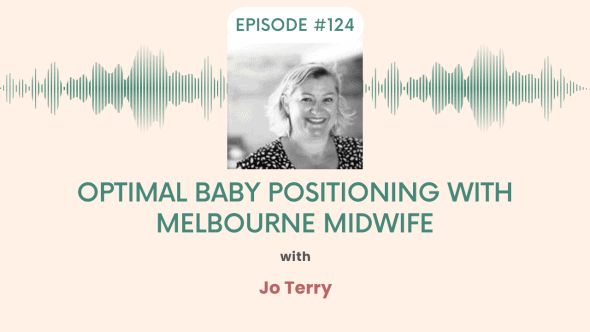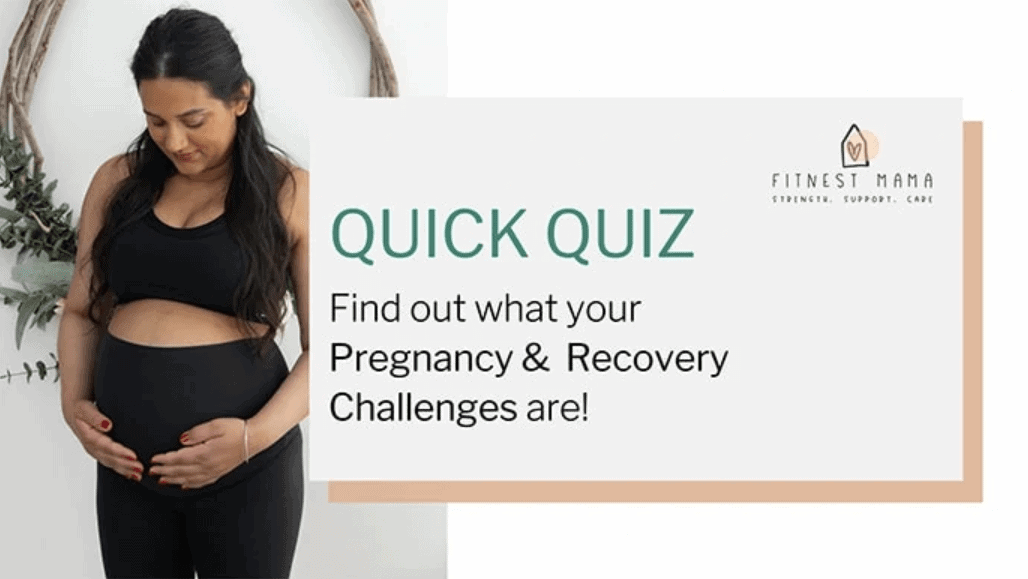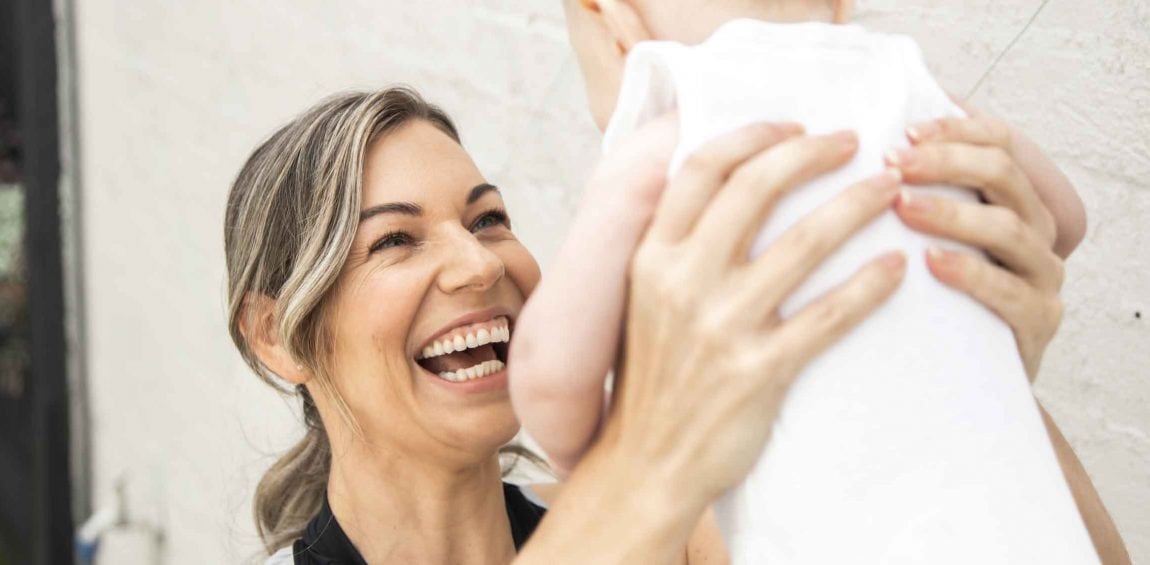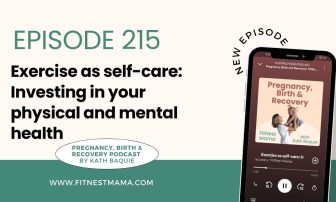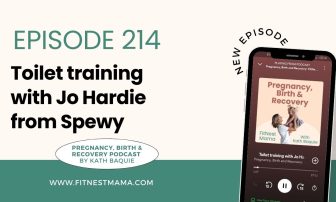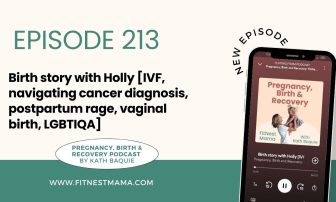If you are pregnant or you’ve recently had a baby, this podcast is for you. I am your host, Kath Baquie. A physiotherapist working in women’s health and a mum of three. Inside my online program, FitNest Mama, I just love helping support women to care for their bodies during pregnancy, prepare their bodies for birth and support their after-birth recovery. Helping them feel confident and strong inside out during this important stage of their lives. In this podcast, join me each week as we dive into all things, pregnancy care, childbirth, and postnatal recovery, helping you through every step of the journey. It is absolutely possible to feel amazing and confident in our bodies during this motherhood journey. And I want that for you. Come and say hi to me on Instagram, @fitnestmama and let’s dive into today’s episode.
Hey, welcome back to another episode of the FitNest Mama Podcast. In this episode today as part of the Preparing for Labour series on the podcast, I’m chatting with Jo Terry who is founder and managing director of Melbourne midwife. She’s also a midwife, a lactation consultant and a childbirth information sharer. So, Jo offers group birthing classes, private education packages and home visits for lactation support. And in this episode today, we are discussing optimal baby positioning. So, it’s a great episode and one which I took away some great information and I’m going to do a little bit of reading from a physio point of view. She offered some really great insights from a seasoned midwife in terms of how to prepare your body for birth.
So, we discussed why is baby positioning so important? Is there anything that mum can do to help with baby positioning and she also talks about things that the birth partner can do. And she discusses at what stage to start optimal baby positioning strategies. So, if this is something you’ve been keen to learn more about this episode is for you.
Before we do dive into this episode, I just would like to invite you to join our Preparing for Labour Workshop. So, in this pregnancy workshop, you learn to help prepare your body and pelvic floor for birth and beyond. So, you learn about pelvic floor preparation you will learn how to do or what perineal massage is, and how it may help to reduce your risk of perineal tears and episiotomy. You’ll learn some different strategies for birth, including act of birth techniques, positions for labour, and we discussed the use of TENS machine and you will learn some after birth recovery essentials to help boost that all important after birth recovery period. So as a women’s health, physio, everything that I share in this free pregnancy workshop are things that I believe every woman deserves to know when pregnant, to really help with a childbirth and after birth experience. To register for this workshop, just head to fitnestmama.com/pregnancyworkshop and the link is also in the show notes. All right, ladies, let’s dive into this episode all about optimal baby positioning with Jo.
KATH BAQUIE
Jo, thank you so much for joining me today on the FitNest Mama Podcast. We’re discussing all things optimal baby positioning, childbirth preparation, and it’s super exciting to have you on board. So, thank you.
JO TERRY
Thank you very much for inviting me. So, it’s an honour. Thank you.
KATH BAQUIE
It’s exciting and we were just talking off air. I’m going to say it. This is your first podcast. I’m really excited.
JO TERRY
It is!
KATH BAQUIE
I’ll try not to scare you off too much.
JO TERRY
Okay. I’ve listened to lots but never been in one.
KATH BAQUIE
Yeah, absolutely. So could you just give the listeners a little quick rundown of who you are. And I’d love to know why. What made you get into this area that you’re in today?
JO TERRY
Yeah, sure. So, my name is Jo Terry and I’m the founder of Melbourne midwife. So, I’m a midwife, and a childbirth educator and a lactation consultant. And at the start of the COVID pandemic, I was working at a major hospital in Melbourne, in their childbirth education department. And because of, you know, the way things kind of panned out, the department pretty much closed its services. People couldn’t, you know, do the group classes and things It’s like that. So, I’ve started a business and the business is just all about, you know, educating women and their partners and their support people into sort of having the birth and baby experience that they’d really love to have. And so, I’m all about, you know, what is it you want? What’s happening in your body? What’s happening with your baby? And how do you actually navigate the system that you’re most probably birthing in? So that’s kind of what I’m all about.
KATH BAQUIE
Yeah. Beautiful. And I know, we could probably talk all day about everything, but we’re going to try it down. Yeah, yep. So, we’re going to try to refine it down to just more than optimal baby positioning, because I know it’s talked about a lot lately, especially on social media. So, let’s start off with is optimal baby positioning important and why?
JO TERRY
Yeah, so I actually think it’s equally as important as the mum dilating. So, there’s two major things happening in birth, the mommy’s dilating and the baby’s navigating the pelvis. And I think in our culture, and certainly in my training, and in, you know, modern medicine, you know, the focus is often on mum dilating. And this sort of sense of this symmetrical dilation. That’s not even kind of necessarily true. And what I found as a midwife, and certainly a lactation consultant, where I see women post birth is that, you know, a lot of intervention happens because babies actually have trouble navigating the pelvis. So, mum might be dilated beautifully, or the dilation may be actually affected by the navigation of the baby. And so just having this understanding that there’s these two really incredibly beautiful things going on together, and they really go hand in hand. And they’re just a really important part of perhaps at work, we, you know, abnormal sort of vaginal birth for a woman.
KATH BAQUIE
Yeah. Okay, so can the baby positioning? Do they? Do they influence each other? For example, if the baby isn’t positioned optimally, can that affect the dilation?
JO TERRY
Absolutely. So, a baby who’s really well positioned in the in the pelvis on sort of that, we call it left anterior, so baby’s back is sort of at the front of the mum a little bit off to the left-hand side of the mom’s body. And if your baby isn’t heavy, it doesn’t have its head nice and well flexed in the pelvis, perhaps baby’s back is facing mums back in a posterior position, or baby’s more off to the right, that beautiful little head isn’t actually pushing well on top of the cervix. So, a really well flexed head has this beautiful shape that actually fits right into the cervix. And every time there’s a contraction, it’s actually the baby that’s helping to open the cervix as well as that sort of muscle contraction. So, what we find is, there’s been I think, over the last 20 years, like a 60% increase of posterior presentations, because of our lifestyle and the way we sit all day, and they are beautiful couches that have us reclining at the end of the day when we’re pregnant. And it can mean for very long, inefficient labour, because even though there’s contractions, they’re not really doing much. So, a woman might be in labour for quite a long time. And we might offer a cervical assessment and, you know, she’s two centimetres or something, and she’s been at it for a while. But you can get that baby to rotate. And then they it fits together like a beautiful puzzle.
KATH BAQUIE
So, is there a way of predicting? So, you’re suggesting that if we can find out if a woman’s getting close to birth, if we can determine the position of her baby? Is that almost a predictive factor in terms of how labour’s going to eventuate? Or can things have changed really quickly?
JO TERRY
Things can change, depending on the mobility and the brightness of your labour. You know, grabbing is a really important factor in that. But ideally, do go into labour left lateral, so the babies on the left-hand side are facing backwards. And we know that they’re sort of the more efficient labours. So yeah, you can like if you’re going to your appointments from sort of 36 weeks onward and the baby’s posterior, I’d be doing lots of things to try and rotate that baby in the actual pregnancy. And the other sort of predictive factor, I would say, would be some pain in your pregnancy in the pelvis. So, I love the analogy of the hot Have you heard the sort of hot air balloon analogy? It’s a fantastic analogy for labour. So, if you imagine a hot air balloon is the uterus and the basket that the people are in other cervix, and then you know how the balloon and the basket are connected by ropes? Well, I sort of see them as being all the soft tissue and the ligaments that are connecting the uterus with the cervix. And pain in pregnancy and my understanding perhaps means that, you know, on one side of that balloon, some of the ropes are shortened. And so, like tight ligaments on one side, which could be you know, from a previous injury, or perhaps you favour one side, or it’s just the way that you’re standing the way that you’re sitting. So sometimes if someone says to me, they’ve got that sort of pain, I’m, I’m like, go and get some body work. So, physio or osteo, in order to balance out those ligaments.
KATH BAQUIE
Are you suggesting that pelvic girdle pain so pain within the glutes that sacroiliac, joint pubic symphysis that has a potential predictive in terms of birth outcomes? And how the ease of birth?
JO TERRY
That’s my understanding of it.
KATH BAQUIE
Really? You going to have to shoot me that research. Because I’m, yeah, that’s amazing. I’d love to read up more on that. Dealing with a lot of women with pelvic girdle pain.
JO TERRY
Because when you think about it, the way a baby rotates in the pelvis, if one particular part of the pelvis is tighter, than that baby is potentially going to get stuck in certain spots.
KATH BAQUIE
I think that’s if the pelvic girdle pain is originating from tightness, whereas there’s art there are lots of potential causes for pelvic girdle pain.
JO TERRY
Yes, yeah, absolutely. And, you know, my understanding of it is very rudimentary compared to perhaps your understanding of, you know, the mechanisms of that. But you know, for example, is say, a baby’s not progressing into the pelvis and things seem to be stuck. Part of something you can do is perhaps like an inversion where you actually put your bottom up with me year, heavy elbows and head down, and you know, six or seven contractions. And what happens is the baby kind of comes back up out of the pelvis, you do a little bit of movement, and the baby can like really navigate.
KATH BAQUIE
Yeah, that totally makes sense. Yeah, love it. That’s great. Okay, well, let’s dive into that a little bit more. So, you’re suggesting maybe at 36 weeks is the time to start including some of these nice positions and postures to help the baby navigate its way. You’ve mentioned inversions. And I love especially at this stage of pregnancy, inside FitNest Mama, we’ve got so many of these beautiful exercises that we do in these positions. So, you’re killing two birds with one stone, you know, we might be working the triceps steps in this sort of gently inverted position. So yeah, I love hearing about this. What are a few different postures and positions that you really like for women to adopt during this period?
JO TERRY
Yeah, so I really love teaching rebozo. Do you know about rebozo?
KATH BAQUIE
Can you explain it to everyone?
JO TERRY
Yeah. So rebozo is sort of a traditional Mexican technique. It’s often used to actually turn a baby from posterior to anterior. But what I like to do in my classes is actually teach partners how to support people how to use rebozo. So, it’s basically a woman is sort of on her hands and knees and you get a large scarf and you make like a hammock around the baby. And the person behind her would actually sort of actually take the weight of the baby using the scarf. And then you just sort of do like this gentle sifting. And what it does is that actually relieves a lot of that pressure for women, because all of a sudden, you know, they’ve been carrying this baby around, and the pelvis is doing a hell of a lot of work. And then, you know, all of a sudden, they get this feeling of, oh, I’m not actually holding the baby. So that would be one of them that I would teach. Another one I really love. I mean, apart from sort of general ball work on a football and you know, lots of circles and figure eight’s and stretches would be this sort of sideline. So, in spinning babies, it’s called shaping the airports, where a woman sort of lays on her side with the top leg tied to describe at the top leg is sort of a little bit higher than the bottom leg. And you’re really just doing this gentle light shaping of the sort of buttocks area, and around the sort of lower back. And that can just help soften. I think sometimes we by the time we actually get to labour that that pelvis is kind of a bit tight and a bit overworked. Yeah, even something as simple as from 36 weeks laying on your side on the couch with your football next to the couch, and that top that top right leg, right over on the fit ball, so that you’ve got that really lovely rotation, which is going to encourage that baby to go into that left lateral position.
KATH BAQUIE
Yeah. So pretty much trying to avoid or limit how much sustain sitting you’re doing during the day.
JO TERRY
Yes. So even if you’re doing this sitting, I think that’s my understanding of it. It’s from at least 36 weeks, preferably earlier, that your hips are always higher than your knees, because when you recline, you know, our knees cover up. And the heaviest part of our baby wants to rotate into the back of the pelvis. And so, you know, if you have to be at work or at a desk, you know, sit on a football because you can’t slouch on a football. When you come home from work that’s sort of not reclining back. That’s super comfy position when you’re pregnant, but actually even laying on your side or even, you know, a couple of cushions on the lounge room full and leaning over your coffee table, sitting backwards on a chair, those sorts of things where hips higher than knees, I think, is probably the simplest way to remember.
KATH BAQUIE
Yeah. And I love what you mentioned about lying down, because that’s great for pelvic floor to rest as well, like 36 weeks everything, you know, the all the weight of your whole pelvis and the baby and the fluid sitting on top of your pelvic floor, your pelvic floor gets very fatigued by the end of pregnancy.
JO TERRY
Yeah, exactly. Yeah. And one of the things that I try and encourage partners with this work is particularly for labour, that sort of idea that in between contractions is kind of actually when we do our opening. And that’s based on how relaxed you are. So, in the mouth, and the jaw is kind of, you know, loose lips, loose hips, we say, but the mouth is sort of representative of the cervix. And so, trying to get the partners to do little simple movements but sort of get the woman to sigh, basically, you wanting to really release all that tension in between contractions. So, this stuff work works very much in labour. And so, part of what I do is encouraging support people to do it throughout the pregnancy. So, by the time they get to labour, they’re really well versed at this idea of getting the body to relax. Yeah, um, so and even if you know, your midwife you know, as busy or, you know, there’s lots going on, there’s someone there who every after every contraction knows what to do with you and your pelvis and your body to help that opening.
KATH BAQUIE
I love that. And this really rings true, because if you’ve listened to our podcast for a while, you know how I talk so much about your pelvic floor relaxation during labour is too important. It’s not a time we want to be zipping up and lifting and closing off that birth canal, which is almost a natural reaction if we’re in any discomfort.
JO TERRY
Exactly.
KATH BAQUIE
So having these strategies that you’re talking about loose lips, relaxing, deep breath, it does help with your whole nervous system, but also pelvic floor too.
JO TERRY
And I had, I had a beautiful moment, the other day, I’ve been and make up like a, it’s called Rose Otto. And it’s like a labour spritz. And it’s a rose, you know, and I was reading that spray actually does loosen the pelvic ligaments. And I was thinking, I was really relating it to, you know, when someone buys you roses, you know, it’s quite a romantic flower and you sigh and you maybe want to make a baby with that person.
Because, you know, I really love that idea, too, that, you know, babies want to be born in the environment in which they made oxytocin. And movement is often held that, you know, babies are conceived all sorts of different ways. But I really love that connection. And I think you know, even your mouth, you know that kissing in early labour can sometimes be really beautiful for the pelvic floor because it opens it.
KATH BAQUIE
Beautiful. Do you sell that rose?
JO TERRY
I do. Yeah. Yeah. Beautiful. Yeah. Sometimes I give it to some lovely clients that do a little bit of a package with me. It’s like, it’s sometimes it is available. Yeah.
KATH BAQUIE
Yeah. Okay, so we’ve talked about why optimal baby positioning, right, we’ve talked about how to do it. And I’d love to know when is it not? When might it not be helpful for a woman to be or is it ever not helpful for a woman to be doing optimal baby positioning exercises?
JO TERRY
Like, I think if you’re, you have any sort of high risk, like perhaps, I know, with rebozo you have to be, you know, you don’t do it if you have a breech baby, or if you have a low-lying placenta. So, there’s, there’s certainly things like that, that you need to be careful about. Everything that you know, I teach is extremely gentle, or at least not that much different from a woman just walking. It’s a really good question I’m trying to think of, yeah.
KATH BAQUIE
I guess even because, do we know how likely this is going? That the likelihood that this will help? Do we know any stats around and this?
JO TERRY
I mean, you know, a lot of it is sort of spinning babies type concept. And there’s a lot of sorts of like, I don’t know, the actual evidence. But you know, there’s a lot of anecdotal evidence around, you know, things like the Gaskin manoeuvre, which is when a woman is in labour, and she has shoulder dystocia, there’s a particular manoeuvre that you can do where you actually, if the woman happens to be on her back, you turn her onto her hands and knees, and it releases the baby. And it just changes that pelvic outlet enough, you know, as midwives to see it all the time, like someone’s in a particular position, and the baby’s just not moving. And then, you know, sometimes even the action of perhaps getting out of the bath, you know, that lunge getting out of the bath can be enough to change the pelvic outlet. So, look, I’m sure there is. Yeah. And I know, as a midwife, I’ve done it countless times where, you know, you can see that baby just needs to rotate.
KATH BAQUIE
Yeah, lovely. And I guess, even if it’s not effective, it’s no harm, is it? So, like, it’s so gentle, as you said, it’s, if you’re doing it 36 weeks, it can just be a really nice, relaxing position. Like even if it’s not going to be effective, it’s still got a lot of other beneficial outcome.
JO TERRY
Well, I mean, well, even just to feel a bit more comfortable in that later stage of pregnancy, you know, perhaps you’re less likely to get an induction because you’re actually feeling a bit more comfortable. And you sleep that easily better. Yeah, yeah. No, no harm at all. Yeah.
KATH BAQUIE
Interesting. Okay, so I know with a keep on chatting all about. Weave, is there anything more you wanted to talk about in terms of optimal baby positioning before we wrapped up?
JO TERRY
Look, I just think just becoming aware of your pelvis, during your pregnancy and really connecting in with it. And I think I often watch women do that really well, by spending lots of time on a fitball. You know, I think it’s just that, you know, some women just seem to have an incredible connection with where the babies and what’s happening. And I just think any work you do in that connection can really help bring about a better chance of the kind of birth you might want to be having.
KATH BAQUIE
Joe you’re speaking my heart. Like I think fitball exercises, but not even exercises, fitball movements, I should call it beautiful during this stage, beautiful for relaxation, but also for your muscles for your pelvis for your baby assist. Yeah, love it.
JO TERRY
Exactly. It’s a really big ask if a woman never sat on a fitball, to then expect she’s going to do a 20-hour labour on a football like, you know, it’s a lot. So yeah.
KATH BAQUIE
Also knowing, like, I teach so many different movements and positions I’m sure you do. But being doing that, for the first time ever in the labour suite with the ball, as you said, it’s not just about sitting on the ball, like there’s so many different positions and postures you can get into with the ball. So, knowing that flexibility or variability beforehand is probably key too.
JO TERRY
Exactly, exactly. And I think particularly for people who are perhaps having a VBAC, where, you know, vaginal birth after caesarean, where, you know, perhaps they had the initial scenario, and because of, you know, the baby didn’t navigate, due to positioning, you know, just having those tools under your belt next time, be really helpful.
KATH BAQUIE
Yeah. Love that. And if you’ve got the tools in your toolkit, then you can pull them out if you need, you might not need them, but at least they’re there, available.
JO TERRY
Yeah, exactly.
KATH BAQUIE
I wish I’d had all these tools when I was pregnant with my first, 10 years ago. No podcast back then.
JO TERRY
I know, yeah, I’ve got 18 and 15-year-old and I had those, you know, 3 day posterior labour. That I think now, finally, I had have known about rebozo, or any of that.
KATH BAQUIE
That’s why I’m so grateful to be able to chat with you today to finish up with any final words of wisdom for pregnant women who might be listening today about Trump on this journey.
JO TERRY
Yeah, I think I think really feel into what you want, and how you want this to all pan out and then do some research and seek some guidance about finding your own way through this and what choices can you make that are actually going to support what you want? Yeah, get really clear about what it is you want and how you’re going to get there.
KATH BAQUIE
Love it? Well, on that note, if you’re based in Melbourne, if the listeners are based in Melbourne, how do they contact you?
JO TERRY
Yeah, so I’m at melbournemidwife.com.au and I run group classes in Coburg, and I do actually live stream my classes as well. So, depending on where you’re listening from, I’ve got the facilities to do that. I’ve had to learn a lot about technology running a business. And I also do home visits for lactation. after the baby’s born, I come to your home and help sort out any problems. But yeah, you can book online. I’m also on Instagram @melbournemidwife. Yeah.
KATH BAQUIE
Perfect. And I’ll put all those links in the show notes, too.
JO TERRY
Thank you very much. Yeah.
KATH BAQUIE
Amazing. Thank you so much for sharing your knowledge today and chatting to us all about optimal baby positioning. It has been great to great to talk, and I’ve learned a couple of things along the way too. So, love it.
JO TERRY
Oh, beautiful, lovely to speak with you. You’re doing great work. Bye.
KATH BAQUIE
That’s it, ladies. Before I sign off, remember my team and I will be putting together the show notes for this episode with all the links including how to connect with Jo and how to get hold of or get access to the Preparing for Labour Workshop at fitnestmama.com/podcast. So that’s it ladies, thank you so much for tuning in. Oh, trust you found this episode super valuable. Come and send me an Instagram message, a DM on Instagram at @fitnestmama. I would love to connect. Until next week. Have a fabulous day everyone and I look forward to you joining me next week for another episode of the FitNest Mama Podcast.
Thanks for listening to the FitNest Mama Podcast brought to you by the FitNest Mama Freebies found at www.fitnestmama.com/free. So please take a few seconds to leave a review, subscribe so you don’t miss an episode. And be sure to take a screenshot of this podcast, upload it to your social media and tag me, @fitnestmama so I can give you a shout out too. Until next time. Remember, an active pregnancy, confident childbirth, and strong postnatal recovery is something that you deserve. Remember our disclaimer, materials and contents in this podcast are intended as general information only and shouldn’t substitute any medical advice, diagnosis, or treatment. I’ll see you soon!
